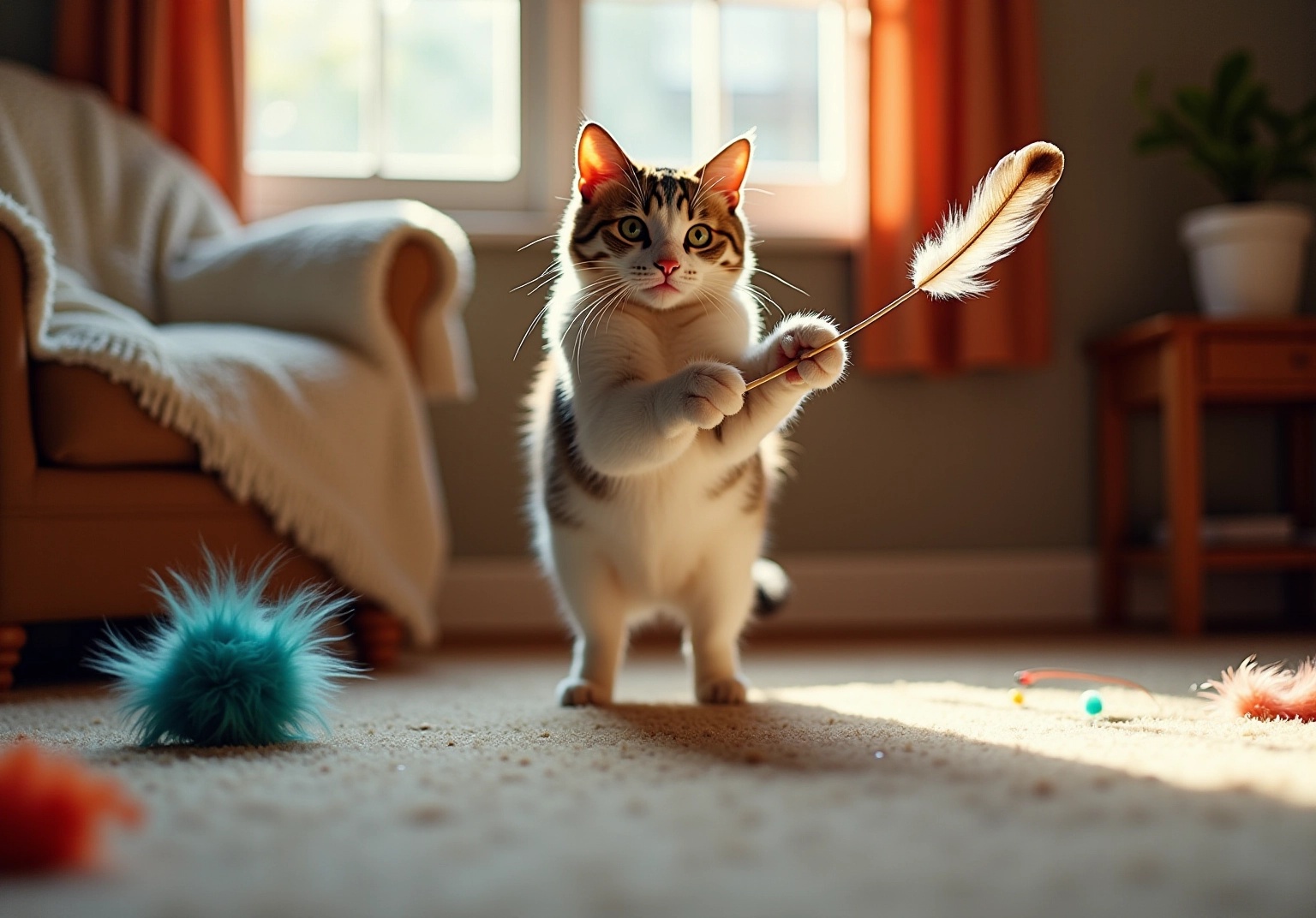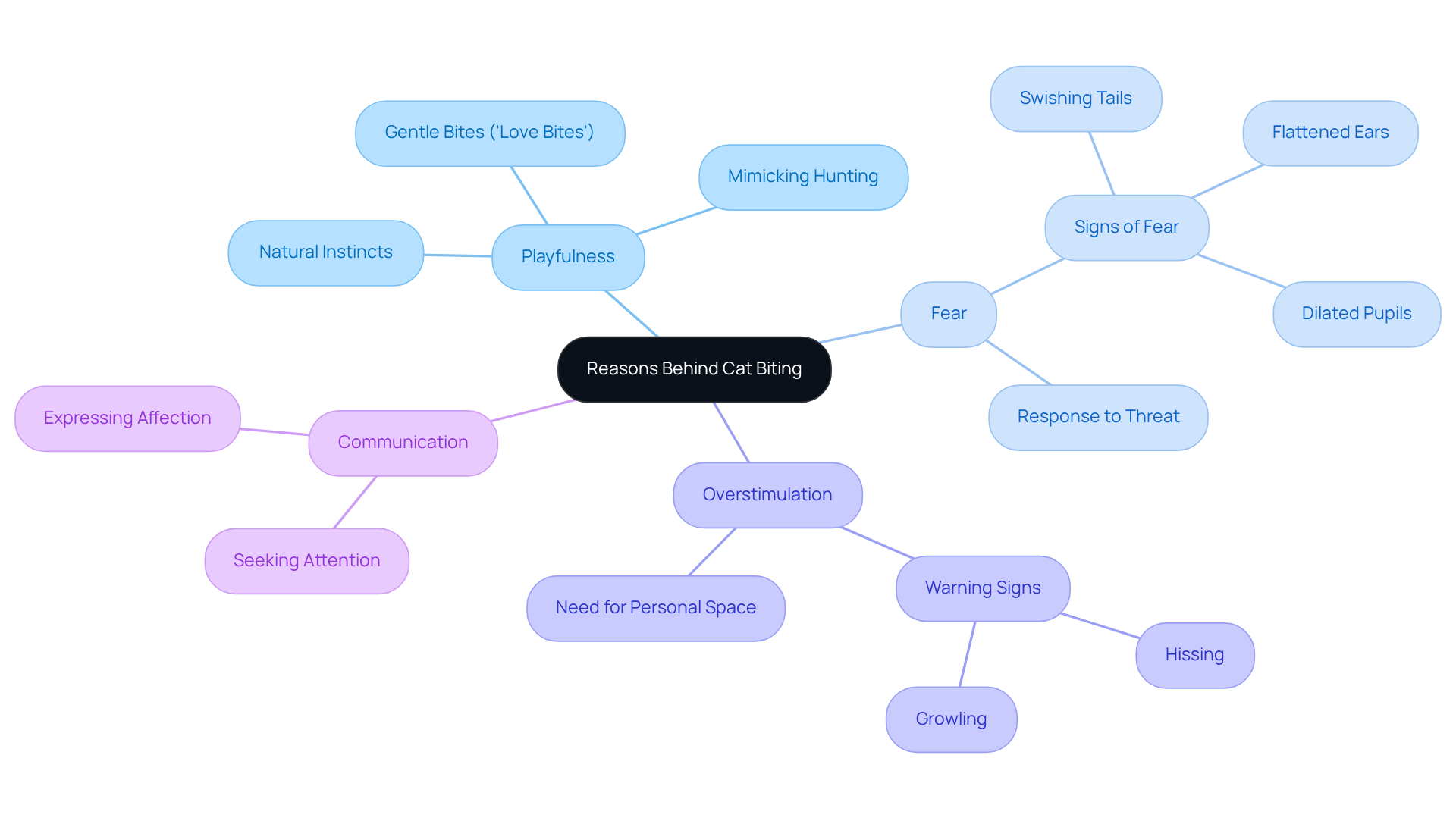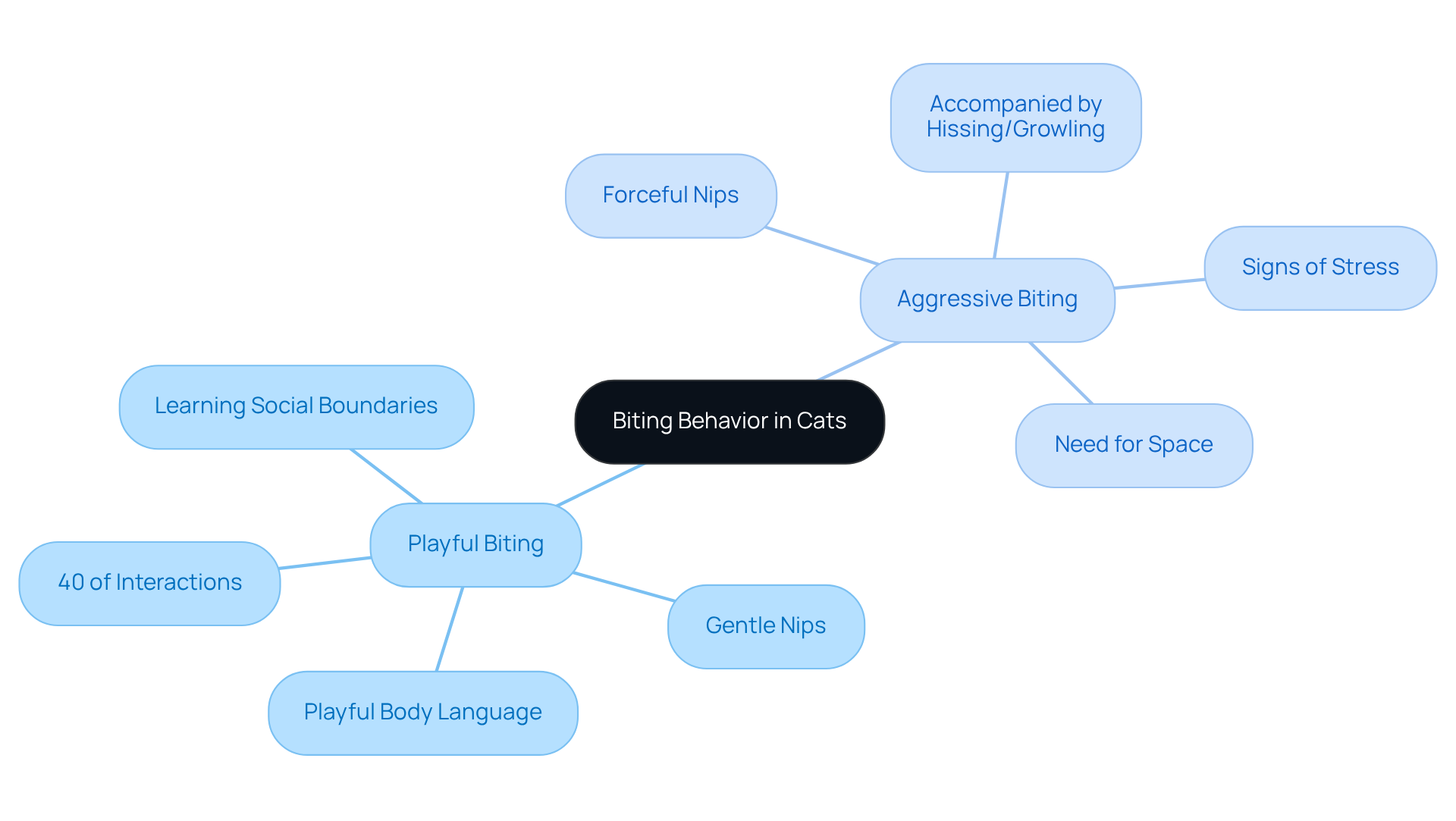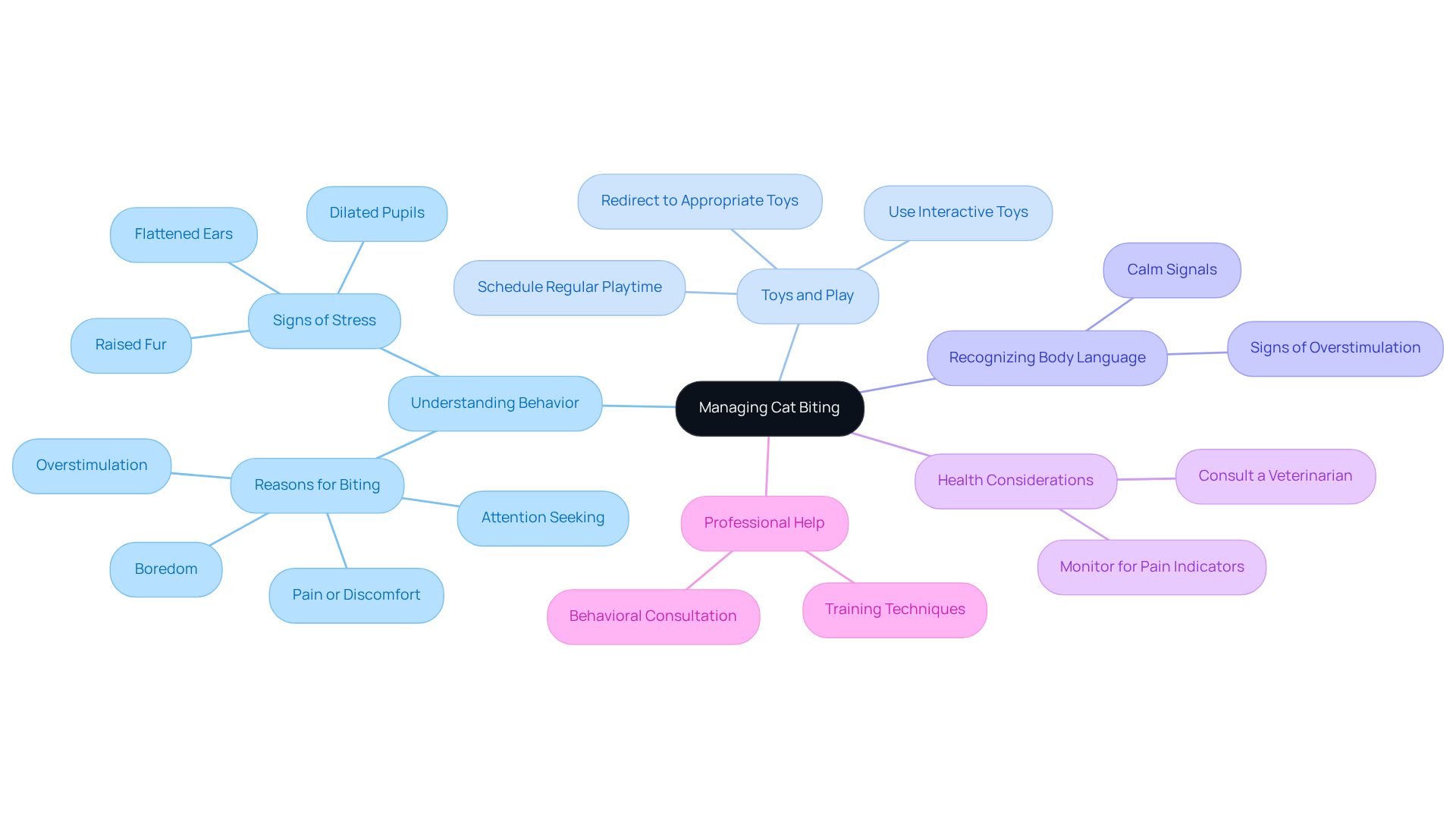
Why Does My Cat Bite Me? Understanding the Reasons Behind Biting
Overview
Cats may bite their owners for a variety of reasons, such as playfulness, fear, overstimulation, or even as a means of communication. It’s essential to understand these behaviors to nurture a positive relationship with your feline friend. Recognizing the warning signs can be a crucial first step in addressing this concern. Providing appropriate playtime and engaging toys not only helps manage biting but also enriches your cat’s life.
It’s important to remember that underlying health issues or past trauma may contribute to this behavior. This understanding can guide you toward seeking professional help when necessary, ensuring that your beloved pet receives the care they need. By fostering an environment of compassion and awareness, you can strengthen the bond with your cat and create a more harmonious home.
Introduction
Understanding the complexities of feline behavior can indeed feel like a puzzling endeavor, especially when grappling with the often perplexing question: why does my cat bite me? This common, yet frequently misunderstood behavior can arise from a myriad of reasons, ranging from playful instincts to signs of discomfort or fear.
It’s natural to feel concerned when our beloved pets exhibit such behaviors. By exploring the motivations behind cat biting, pet owners can uncover valuable insights that not only enhance their bond with their furry companions but also cultivate a safer, more harmonious home environment.
What drives these affectionate yet sometimes aggressive nibbles? How can we, as caring pet owners, discern between playful antics and genuine distress? These are important questions that deserve our attention and understanding.
Understand the Reasons Behind Cat Biting
Cats display gnawing actions for various reasons, including playfulness, fear, overstimulation, and communication, prompting the question: why does my cat bite me? Caring pet owners must understand why does my cat bite me to effectively nurture their feline companions. For instance, during playtime, a cat may bite as part of its natural instinct, mimicking hunting behaviors. However, gnawing can also signal discomfort or a need for personal space, particularly if the cat feels threatened or overstimulated. Recognizing warning signs—such as swishing tails, flattened ears, or dilated pupils—can empower owners to respond appropriately, fostering a harmonious bond with their beloved pets.
Research indicates that factors like past trauma, insufficient social interaction, or underlying health issues can help explain why does my cat bite me. For example, a cat that hasn’t learned nipping restraint during its kittenhood may continue this behavior into adulthood. Veterinary experts emphasize the importance of closely observing a cat’s behavior and seeking professional guidance when necessary. Dr. Greco cautions, “Cat injuries are extremely dangerous due to the bacteria present in a cat’s mouth!” If gnawing becomes frequent or severe, it may indicate pain or discomfort, making a veterinary check-up a compassionate choice.
Moreover, gentle bites, often referred to as ‘love bites,’ can express affection, especially when paired with licking. Understanding the nuances of cat behavior can help owners answer the question of why does my cat bite me, allowing them to manage nipping effectively and ensuring that interactions remain positive and loving. By providing ample playtime, engaging toys, and recognizing when a cat has reached its limit, owners can significantly reduce the likelihood of undesirable nipping incidents. Additionally, understanding why does my cat bite me is essential, as cats may bite as a form of communication when they feel neglected and are yearning for affection from their owners, underscoring the importance of regular, loving interaction.

Differentiate Between Playful and Aggressive Biting
Playful nipping is typically characterized by gentle nips and is often accompanied by playful body language, such as pouncing, rolling, or relaxed postures. It’s heartening to note that 40% of observed cat interactions were playful, characterized by wrestling without vocalization.
However, when we encounter aggressive biting, it becomes more forceful and may be accompanied by hissing, growling, or a tense body posture, signaling that the cat feels threatened or stressed. Recognizing these differences is essential for pet owners; playful nibbles are generally harmless and part of normal feline behavior, while aggressive nips may lead one to question, ‘why does my cat bite me,’ as they can indicate underlying issues such as fear or discomfort.
For instance, if a cat nips during play without breaking the skin, it is likely engaged in a playful interaction. Yet, if the gnawing is coupled with aggressive body language—like flattened ears or dilated pupils—it may suggest that the cat needs space or is feeling cornered.
Additionally, playful nipping plays a vital role in helping kittens learn to regulate bite strength and establish social boundaries. Understanding these cues allows owners to respond appropriately, whether by redirecting play with interactive toys or providing a safe retreat for their cat.
It’s also important to remember that play can escalate into aggression due to overstimulation or external triggers, so monitoring playtime dynamics is crucial. If nipping persists despite training and enrichment, it may be necessary to consult a veterinarian or animal behaviorist to understand why does my cat bite me and address any underlying issues. Your cat’s well-being is of utmost importance, and taking these steps can foster a happier, healthier relationship.

Implement Strategies to Manage and Reduce Biting
Understanding why does my cat bite me is an important part of managing and reducing biting habits in cats, making it a heartfelt journey for pet owners. It’s important to recognize how distressing this behavior can be, not just for you, but for your beloved feline as well. Providing appropriate toys is crucial; interactive options like feather wands and laser pointers can engage your cat’s natural hunting instincts, all while keeping your hands safe from those playful nips. Establishing a stable routine that includes regular playtime can significantly alleviate boredom, which is often a root cause of aggressive actions.
Understanding your cat’s body language is equally vital. Signs of overstimulation, such as twitching tails or flattened ears, are clear indicators that your cat needs some space. By being attuned to these signals, you can foster a more peaceful environment. Positive reinforcement methods, such as offering treats or gentle compliments for calm play, can further encourage desirable behavior.
In some cases, nipping may stem from underlying health issues or anxiety, raising the question of why does my cat bite me. If you suspect this might be the case, consulting with a veterinarian or a feline behavior expert can provide valuable insights and tailored strategies for improvement. It’s also important to remember that cat scratches can introduce bacteria like Staphylococcus and Streptococcus into your body, so addressing these issues with care is essential.
As Dr. Stephanie Liff points out, extreme cases of biting may require professional intervention, underscoring the significance of addressing this behavior promptly. By implementing these compassionate approaches, you can create a safer and more harmonious environment for both yourself and your cherished feline companion.

Conclusion
Understanding why cats bite is crucial for fostering a loving and safe relationship between pets and their owners. This behavior can stem from various motivations, including:
- Playfulness
- Fear
- Overstimulation
- The need for communication
By recognizing the underlying reasons for biting, owners can respond appropriately and ensure that their feline companions feel secure and understood.
The article highlights the importance of differentiating between playful and aggressive biting, emphasizing that playful nips are often harmless and part of a cat’s natural behavior. In contrast, aggressive biting may indicate stress or discomfort, requiring immediate attention. Key strategies such as:
- Providing appropriate toys
- Recognizing body language
- Establishing a routine
can significantly reduce biting incidents. Additionally, consulting with a veterinarian or behaviorist can address any underlying issues that may contribute to this behavior.
Ultimately, understanding and managing cat biting is not just about preventing discomfort; it is about enhancing the bond with a beloved pet. By implementing compassionate strategies and being attentive to a cat’s needs, owners can create a harmonious environment that nurtures both their well-being and their own. Embracing this journey of understanding will lead to a happier, healthier relationship with feline companions, making the effort well worth it.
